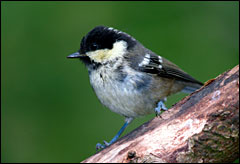Hi Umbra,
I agree with your analysis of bird feeders, and would like to share a win-win solution. I have a huge variety of birds that visit my yard year-round. Instead of bird feeders, I have planted an abundance of native plants, including trees, bushes, and groundcover plants that provide berries, seeds, nesting material, and shelter throughout the year. In addition, I use organic gardening methods, and spread worm castings from my worm composter as fertilizer. The rich, pesticide-free soil therefore provides a rich food source for ground-feeders.
Peggy Green, environmental science professor
Margate, Fla.
Dearest Peggy,
How many times per week does someone comment on your last name? It’s like if I were a professional … uh, a … hmm.

Backyards are part of a bird-joining movement.
Photo: iStockphoto
I agree with you, too, with your vote for gardens as a bird attractant, buffet, and shelter. So onward to suggestions for others about luring birds to the yard.
First off, why bother? Ecologically, the reasons are compelling. Animals need certain foods, certain habitats, certain other animals, plants, and insects to survive and thrive. We humans have chosen pavement as a habitat. Well-planned gardens amidst the asphalt are sanctuaries for otherwise stranded small animals and insects. A neighborhood series of linked habitats creates a little wildlife corridor. Altruism in the form of a backyard wildlife sanctuary will reward us: Birds are cute, and provide a soothing bucolic atmosphere, what with their charming noises and flitting. Even the bird-indifferent can be won over by a nice herd of black-eyed juncos furtively — but nicely — zipping about in the morn.
Birds develop niches in tandem with plants, so using certain native plants in your landscape will logically assist struggling native birds. Native plantings are also a low-maintenance garden choice, as they are hardy, do well in the climate and thus succumb to fewer pests, and require infrequent or no watering.
Enough with the proselytizing — how does one begin to create a bird haven? Gather inspiration before the daunting design step. Visit a botanical or zoological garden in the area, or even a well-designed park or campus, to see how native plants can be arranged for aesthetic and ecological effect. Look on the internet to find your local Backyard Wildlife Sanctuary organization, local native-plant society, and local bird peeps. Ask gardener pals about the plants you like, or they like, and write the names down. Do the opposite, as well: learn which plants attract which birds, then go look and find out if you like the plant. Then, using resources from the native plant or backyard or bird people, start to make a list of the plants you think you want.
The Cornell Ornithology Lab uses a clever system of seven groups of plants that will attract birds: conifers, grasses and legumes, nectar-producers, summer-fruiting, fall-fruiting, winter-persistent, nut and acorn. With a little research as described above, or in any decent regional gardening book, you should be able to make a list of plants you like in each category. As you plan and plant, and maintain your garden, keep birds in mind. Create dense thickets, leave some dead wood lying about, and make a bit of a “mess.” Birds and the bugs they eat will do better given undisturbed piles of brush, mounds of old seed heads and flowers lying about, perennials left untrimmed for the winter so they can browse the old seeds and perch upon the stalks. That is to say, a half-tended yard will go to the birds.
Tweetily,
Umbra


